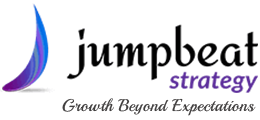BUSINESS STRATEGY

Andy Lambrecht, CEO, Jumpbeat Strategy
12 May 2020

Photo by QuinceCreative on Pixabay
Events that affect the entire globe in a relatively short span of time are historically very rare – think World War II or the asteroid or comet that impacted the Earth and caused the extinction of 75% of plant and animal species. Their effects are much longer lasting. The 9/11 terrorist attack had a near instant impact on global air travel and businesses located or dependent on lower Manhattan. World War II developed over several years. COVID-19 is unprecedented in its effect and its impact was felt in a matter of weeks. Throughout the world, most businesses have either had to adapt or shutdown altogether. Many businesses are being forced to innovate or die.
I am not talking about revolutionary inventions such as the airplane, the internal combustion engine, or the incandescent light bulb. Although a revolutionary invention may occur, I am talking about countless smaller innovations and improvements that, when combined, will transform entire industries. Electricity and electrification were not single events, but were instead, a series of discoveries and inventions spanning more than 2000 years that came together over approximately 30 years to contribute to the second industrial revolution.
What Drives Innovation?
Innovation is typically driven by a problem or the application of a new technology or discovery. A study published by Josef Taalby of Lund University (link here), describes that sources of innovation fall into four categories: solutions to problems, technological opportunities, market opportunities, and institutional search. The vast majority of innovations within the scope of the study fell into the first two categories with “solutions to problems” being the largest source of innovation. Innovations can be categorized in different ways, but I prefer look at innovations as revolutionary (or radical), disruptive, incremental, and sustaining as determined by the newness and impact of technology and the resulting impact on the market.
Competitive survival and the desire to create new disruptive businesses have been primary motivations in the past. Now, businesses are looking for new ways to survive and grow and new opportunities will be identified.
A Perfect Storm
COVID-19 has created a perfect storm for innovation: a discrete event that has impacted the globe, significant new technologies and new scientific knowledge. Plato said, “necessity is the mother of invention”. COVID-19 has certainly created an abundance of necessity. Countless “problems” have been exposed within businesses, within industries, in the healthcare system, in governments, etc. The number of problems that can be solved is probably at a historic level. At the same time, technologies are advancing and coming of age.
Technologies that are advancing rapidly and are likely to be applied heavily include artificial intelligence and machine learning (AI/ML), genomics, robotics, nanotechnology and sensors. Combined with individual situations where people may have their backs to the wall or some incentive to think, create a situation that is ripe for innovation.
Where Will We See Innovation?
We are used to the constant pace of innovation as seen in bigger and more capable TVs, advancements in smartphones, and increased storage capabilities. These advancements are predictable, described commonly by Moore’s law and driven by competition. The coming wave is driven by necessity. Businesses have been forced to change almost overnight – in some cases it was overnight.
We will see accelerated innovation everywhere, from new business models to innovations in business operation to innovations that disrupt whole industries. Much has been written about how the way we work will change and new tools will be developed to allow us to work more remotely. Some businesses will need to change their business model and new business models are likely to emerge. Many businesses saw their supply chain or distribution channels disrupted and there will be innovation in these areas to protect against future disruption while creating competitive advantage. Remote or virtual activities, such as voting, where the identity of the person needs to be verified and trusted, will accelerate innovations and adoption of digital ID and trust technologies.
Some businesses already have active disaster planning. H-E-B, the Texas-based grocery chain lauded for it’s planning and response to the COVID crisis (Texas Monthly Article), has a full-time position responsible for emergency preparedness with plans that have been put into action previously. More businesses will establish formal disaster planning activities.
Every industry will see innovation directly as a result of COVID-19. Some examples include:
Healthcare – COVID is a health issue so it is not surprising that this industry will be rich in innovation opportunities. The healthcare system has been stressed and there will be innovation as a result. Artificial intelligence is already being applied to discovering treatments and I expect will find other new applications. Apple and Google acted quickly to define API’s (Application Programming Interface) so that smartphones can be used as part of a contact tracing solution. Surveillance technology to identify and track infected individuals will be developed.
New Innovations in diagnosis, treatment, monitoring, early detection, contact tracing, and other areas should be expected and accelerated with the development of new sensors and artificial intelligence. Healthcare workers have been infected at unusual rates by this virus and medical robotics, deployed in limited numbers today, will become increasingly important and innovation will accelerate. Robots will offload tasks from overstressed healthcare workers and will be put into highly infectious situations to protect them.
Hospitality & Entertainment – Movie theaters have shut down. Restaurants have had to shift to delivery and pick-up only or close completely. Those restaurants that chose to remain open adapted by adding meal and cocktail kits to their menus and selling fresh meats, produce and other grocery items which also helped their suppliers. True Respite Brewing Co. in Maryland created Bierme, an online portal allowing their customers to order online for pick up and delivery and made Bierme available to other craft brewers creating a new revenue stream for True Respite.
The releases of blockbuster movies have been delayed while movies with lower expectations have skipped theatrical release and gone straight to streaming. Major studios have already said publicly that they are rethinking their release strategy beyond COVID-19. Studios are likely to create virtual blockbuster releases so they won’t need to be delayed in the future. Theme parks will create new streams of revenue that can continue when parks have to be shut down.
Education – The education system has often been criticized for being stuck in the past. With COVID-19, classroom education has been put on hold and school systems have taken a variety of approaches to the temporary situation. This has opened the door for massive innovation beyond COVID-19 in how our education systems work. I expect to see large changes in our current classroom model as well as new alternatives to classroom learning.
Government – Our governments have had to respond and scale in ways they have never had to before. Our public servants have taken action and performed bravely. Services that were probably overdue to go online have had move online out of necessity. There should be a great deal of innovation in our governments. The COVID crisis should accelerate progress toward electronic voting which will require advances in trusted ID and security to protect the integrity of elections. New tools will be created that allow governments to operate remotely and with increased transparency.
Automotive & Transportation – COVID-19 put many transportation riders and drivers at risk. This will accelerate development and deployment of autonomous vehicles and the innovations that are necessary for deployment, adoption and growth.
Manufacturing – Automation of factories will increase to minimize the need of human workers. There will be increased incentive to innovate to automate tasks and processes which have been difficult to automate previously. This will be enabled by new sensors, AI/ML, and new processes.
This is just a sampling of industries that will see increases in innovation. There are businesses and industries that have been boosted by COVID-19, but these have been stressed in ways that expose problems that will drive innovation. Referring back to H-E-B, new partnerships have been created with local restaurants as a trial to sell pre-prepared meals, helping restaurants survive and helping boost their own sales.
How will this affect us in the future?
This is the deadliest, most virulent pandemic since the 1918 Spanish Flu. Yes, we have had SARS, MERS, and H1N1 over the past 20 years, but these weren’t as severe as the current pandemic. Will it be another 100 years before another pandemic of this severity? Or will we see more frequent severe pandemics in the form of SARS-CoV-2 mutations or another new virus? Some of the innovations we see will address how we respond to future pandemics or other disruptive situations whereas other innovations will accelerate us into a new future that is different than the future that existed prior to COVID-19. Who will take action and who will let their ideas pass?
To explore how Jumpbeat Strategy can grow your business, contact us for a free consultation.
